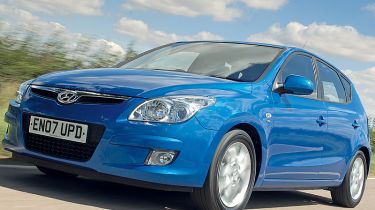Hyundai i30 Estate review (2007-2011)
Top value alternative to mainstream compact family hatchbacks from Hyundai.

Driving
The i30 shares its platform with the Kia Cee’d, but has slightly revised suspension settings. It feels composed and reassuring, and while it’s far from inspiring to drive, it is comfortable and refined enough. Long journeys won’t be a chore. The same range of 1.6-litre and 2.0-litre petrol and diesel engines are used, too – but Hyundai has made a few changes which improve refinement. There’s also a 1.4-litre petrol entry-level car, and we found little difference in performance between this and the 1.6; however, if you can afford it, go for the excellent 1.6-litre diesel. It has impressive punch, particularly when pulling out of junctions.
Marketplace
The i30 is a vital car for Hyundai. It has to consign the maker’s ‘bargain’ image to history, pushing quality and driveability forward. Sister company Kia has already enjoyed such success with the Cee’d, and significantly, both cars are essentially the same, even down to doors and dashboard. The Hyundai has a bluffer nose though, and elongated rear lights that have a touch of Mercedes A-Class about them. The flat, recessed tailgate also looks a bit BMW 1-Series. The five-door hatch will, in time, be joined by an estate and three-door version, and for now is offered in Comfort, Style and Premium variants. All are generously equipped, and keen pricing also works in the Hyundai’s favour; it’s pitched below mainstream rivals such as the Ford Focus, Vauxhall Astra and Toyota Auris.
Owning
The well-constructed interior offers a comfortable seating position and plenty of rear space. The i30 actually has more rear legroom than the already-spacious Cee’d. The boot is practical, and as the rear seatbases flip, you can create a virtually flat load area. The trouble is, lower-end models don’t look as robust as they actually are, due to a large expanse of dull plastic. More upmarket variants get a leather steering wheel and metal-effect centre console. All models are very well equipped though, with even entry-level versions offering ESP, alloys, electric windows, air con and a USB auxiliary port. What’s more, the i30 offers a five-year warranty, though this is still two years less than the Cee’d. Retained values are better than the Kia though, with the Hyundai holding on to just under 39 per cent after three years.







